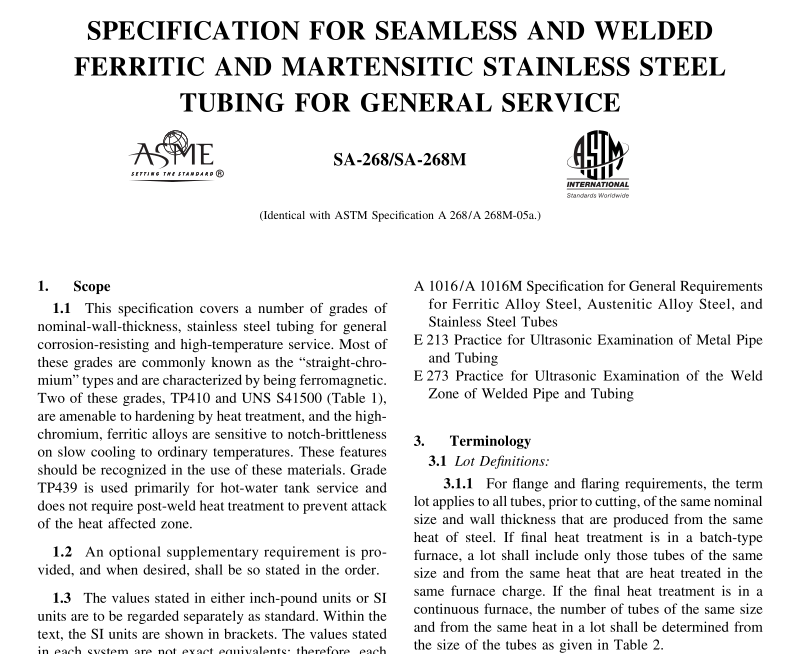ASME SA268:2010 pdf free download SPECIFICATION FOR SEAMLESS AND WELDED FERRITIC AND MARTENSITIC STAINLESS STEEL TUBING FOR GENERAL SERVICE
4.1.1Quantity (feet,metres,or number of lengths),4.1.2 Name of material (seamless or welded tubes),4.1.3 Grade (Table 1),
4.1.4Size (outside diameter and nominal wallthickness),
4.1.5 Length (specific or random),
4.1.6Optional requirements (hydrostatic or nonde-structive electric test,Section 16),
4.1.7Test report required (Certification Section ofSpecification A 1016/A 1016M),
4.1.8 Specification designation,
4.1.9 Intergranular corrosion test,and4.1.10 Special requirements.
5.General Requirements
i5.1 Material furnished under this specification shallconform to the applicable requirements of SpecificationA 1016/A 1016M unless otherwise provided herein.
6. Manufacture
6.1The tubes shall be made by the seamless or weldedprocess with no filler metal added.
7. Heat Treatment
7.1As a final heat treatment, tubes shall be reheatedto a temperature of 1200°F[650°C] or higher and cooled(as appropriate for the grade) to meet the requirements ofthis specification.
7.2The martensitic grade UNS S41500 shall bereheated to a temperature of 950°F[510°C] or higher andcooled as appropriate to meet the requirements of thisspecification.
8. Chemical Composition
8.1The steel shall conform to the chemical require-ments prescribed in Table 1.
9.Product Analysis
9.1An analysis of either one billet or one length offlatrolled stock or one tube shall be made from each heat.The chemical composition thus determined shall conformto the requirements specified.
9.2The product analysis tolerance of the ChemicalRequirements Table of A 480/A 480M shall apply. The product analysis tolerance is not applicable to the carboncontent for material with a specified maximum carbon of0.04% or less.
9.3If the original test for product analysis fails,retestsof two additional billets,lengths of flat-rolled stock ortubes shall be made. Both retests for the elements in ques-tion shall meet the requirements of the specification; other-wise all remaining material in the heat or lot shall berejected or, at the option of the producer.each billet ortube may be individually tested for acceptance. Billets,lengths of flat-rolled stock or tubes which do not meet therequirements of the specification shall be rejected.
10.Tensile Requirements
10.1 The material shall conform to the tensile propertiesprescribed in Tables 3 and 4.
11.Hardness Requirements
11.1 The tubes shall have a hardness number not toexceed those prescribed in Table 5.
12.Permissible Variations in Dimensions
12.1Variations in outside diameter, wall thickness, andlength from those specified shall not exceed the amountsprescribed in Table 6.
12.2The permissible variations in outside diametergiven in Table 6 are not sufficient to provide for ovalityin thin-walled tubes, as defined in the Table.In such tubes,the maximum and minimum diameters at any cross sectionshall deviate from the nominal diameter by no more thantwice the permissible variation in outside diameter givenin Table 6; however, the mean diameter at that cross sectionmust still be within the given permissible variation.
12.3When the specified wall is 2%o or less of thespecified outside diameter, the method of measurement isin accordance with the agreement between the purchaserand the manufacturer (see Note 1).
NOTE1 — Very thin wall tubing may not be stiff enough for the outsidediameter to be accurately measured with a point contact test method,such as with the use of a micrometer or caliper.wWhen very thin wallsare specified. ““go”-“no go” ring gages are commonly usedi to measurediametcrs of 1%in. [38.1 mm] or less.A0.002 in. [0.05 mm] additionaltolerance is usually added on the “go” ring gage to allow clearance forsliding. On larger diameters,mcasurement is commonly performed witha pi tape. Other test methods such as optical test mcthods may also beconsidered.
13. Surface Condition
13.1All tubes shall be free of excessive mill scale,suitable for inspection. A slight amount of oxidation will
ASME SA268:2010 pdf free download
